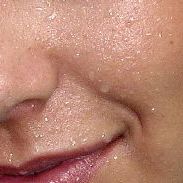
Back تعرق Arabic Sudu AST ГӀетӀ AV पसीना AWA Jump'i Aymara Tər Azerbaijani Peluh BAN Ganot BCL Пот Byelorussian Пот BE-X-OLD
This article about biology may be excessively human-centric. |
| Perspiration | |
|---|---|
| Other names | Sweating, hidrosis, diaphoresis |
 | |
| Droplets of perspiration on the skin | |
| Specialty | Dermatology |
| Symptoms | Body odor |
| Complications | Dehydration |
| Causes | Fever Heat Hyperthermia Hot flash |
| Prevention | Drinking water |
| Treatment | Antiperspirant |
Perspiration, also known as sweat, is the fluid secreted by sweat glands in the skin of mammals.[1]
Two types of sweat glands can be found in humans: eccrine glands and apocrine glands.[2] The eccrine sweat glands are distributed over much of the body and are responsible for secreting the watery, brackish sweat most often triggered by excessive body temperature. Apocrine sweat glands are restricted to the armpits and a few other areas of the body and produce an odorless, oily, opaque secretion which then gains its characteristic odor from bacterial decomposition.
In humans, sweating is primarily a means of thermoregulation, which is achieved by the water-rich secretion of the eccrine glands. Maximum sweat rates of an adult can be up to 2–4 litres (0.53–1.06 US gal) per hour or 10–14 litres (2.6–3.7 US gal) per day, but is less in children prior to puberty.[3][4][5] Evaporation of sweat from the skin surface has a cooling effect due to evaporative cooling. Hence, in hot weather, or when the individual's muscles heat up due to exertion, more sweat is produced. Animals with few sweat glands, such as dogs, accomplish similar temperature regulation results by panting, which evaporates water from the moist lining of the oral cavity and pharynx.
Although sweating is found in a wide variety of mammals,[6][7] relatively few (apart from humans, horses, some primates and some bovidae) produce sweat in order to cool down.[8] In horses, such cooling sweat is created by apocrine glands[9] and contains a wetting agent, the protein latherin, so it transfers from the skin to the surface of their coats.[10]
- ^ Mosher HH (1 February 1933). "Simultaneous Study of Constituents of Urine and Perspiration". Journal of Biological Chemistry. 99 (3): 781–790. doi:10.1016/S0021-9258(18)76026-2. S2CID 43499897.
- ^ Hanukoglu I, Boggula VR, Vaknine H, Sharma S, Kleyman T, Hanukoglu A (January 2017). "Expression of epithelial sodium channel (ENaC) and CFTR in the human epidermis and epidermal appendages". Histochemistry and Cell Biology. 147 (6): 733–748. doi:10.1007/s00418-016-1535-3. PMID 28130590. S2CID 8504408.
- ^ Jessen C (2000). Temperature Regulation in Humans and Other Mammals. Berlin: Springer. ISBN 978-3-540-41234-2.
- ^ Mack GW, Nadel ER (1996). "Body fluid balance during heat stress in humans". In Fregly MJ, Blatteis CM (eds.). Handbook of Physiology. Section 4: Environmental Physiology. New York: Oxford University Press. pp. 187–214. ISBN 978-0-19-507492-5.
- ^ Sawka ML, Wenger CB, Pandolf KB (1996). "Thermoregulatory responses to acute exercise-heat stress and heat acclimation". In Fregly MJ, Blatteis CM (eds.). Handbook of Physiology. Section 4: Environmental Physiology. New York: Oxford University Press. ISBN 978-0-19-507492-5.
- ^ Goglia G (January 1953). "Italian: Cavia cobaya, Sus scrofa, Equus caballus" [Further research on the branched sweat glands in some mammals]. Bollettino della Società Italiana di Biologia Sperimentale (in Italian). 29 (1): 58–60. PMID 13066656.
- ^ Robertshaw D, Taylor CR (November 1969). "Sweat gland function of the donkey (Equus asinus)". The Journal of Physiology. 205 (1): 79–89. doi:10.1113/jphysiol.1969.sp008952. PMC 1348626. PMID 5347721.
- ^ Jenkinson DM (April 1973). "Comparative Physiology of Sweating". British Journal of Dermatology. 88 (4): 397–406. doi:10.1111/j.1365-2133.1973.tb07573.x. PMID 4582049. S2CID 35727313.
- ^ McCutcheon LJ, Geor RJ (1998). "Sweating: Fluid and Ion Losses and Replacement". Veterinary Clinics of North America: Equine Practice. 14 (1): 75–95. doi:10.1016/s0749-0739(17)30213-4. ISSN 0749-0739. PMID 9561689.
- ^ McDonald RE, Fleming RI, Beeley JG, et al. (2009). Koutsopoulos S (ed.). "Latherin: A Surfactant Protein of Horse Sweat and Saliva". PLOS ONE. 4 (5): e5726. Bibcode:2009PLoSO...4.5726M. doi:10.1371/journal.pone.0005726. PMC 2684629. PMID 19478940.
© MMXXIII Rich X Search. We shall prevail. All rights reserved. Rich X Search